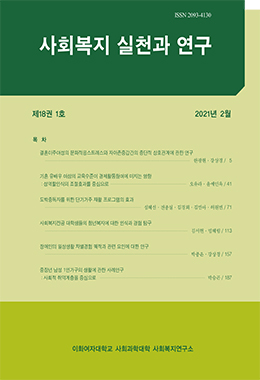본 연구는 아동학대에 있어 아버지의 역할에 대한 이해도를 높이고자 아버지의 특성이 아동이 경험하는 학대의 유형 (신체, 정서, 성학대 및 방임)에 미치는 영향을 조사하였다. The National Survey of Child and Adolescent Well-being (NSCAW-I) 데이터의 0세부터 15세 사이 아동 3,387명을 대상으로 로지스틱 회귀분석을 실시하였다. 분석결과, 생물학적 친아버지와 같이 사는 아동들에 비하여, 아버지가 부재한 가정에 사는 아동들 또는 양아버지와 사는 아동들이 신체적 학대, 정서적 학대, 그리고 방임을 경험할 확률이 높은 것으로 드러났다. 생물학적 친아버지와 같이 사는 아동들의 경우, 아버지의 가정폭력이 신체, 정서 학대 및 방임 확률을 높이지만 성학대 확률은 낮추는 것으로 나타났다. 또한 아버지가 실업상태인 경우 아이들의 정서학대 및 방임 확률이 높은 것으로 밝혀졌다. 본 연구결과, 다양한 아버지 관련 요소들이 특정한 아동학대 유형과 연관이 있는 것으로 나타났다. 따라서 더 포괄관적으로 아버지 관련 특성을 조사하고 이를 반영하여 효과적이 아동학대예방대책프로그램을 개발하는 노력이 필요할 것으로 사료된다.
The current study sought to improve our understanding on the role of fathers in maltreatment by examining how various paternal characteristics were associated with four types of maltreatment: physical, emotional, sexual abuse, and neglect. A total of 3,387 children between the ages of birth and 15 years at baseline were drawn from the National Survey of Child and Adolescent Well-being (NSCAW-I). A series of logistic regression analyses were performed to examine the association between paternal characteristics and maltreatment type. Results revealed that children with a non-biological father living in the home and children without a father or father figure in the home had higher odds of physical abuse, emotional abuse, and neglect than children with a biological father in the home. For children living with biological fathers, domestic violence was associated with higher odds of physical abuse, emotional abuse, and neglect, but with lower odds of sexual abuse. Father unemployment was associated with higher odds of emotional abuse and neglect. The findings suggested that diverse father-related factors were linked to specific types of maltreatment risk, highlighting the need for a comprehensive assessment of various paternal characteristics for effective maltreatment prevention.


